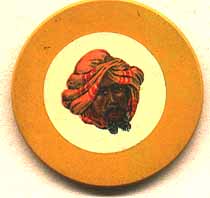|
|
|
I have been busy dissecting more Crest and Seal chips and talking to Jim Blanchard, President of Atlantic Molding, a successor of sorts to the Burt Co., which took over U S Playing Card Co's. chip business in 1949. These are some observations:
(1) The word "seal" can have many different meanings, as I said before. It could be an official stamp or crest. But often I thought of it as sealing an entire chip, that is, covering the entire surface of a chip. So I cut up the Florida Palm chip and the thin, round-edged BPOE #99 chip, and to my surprise the thin, separate, transparent laminate (often called cellulose nitrate) over the inlay protects (or seals) ONLY the inlay on these two classic Crest and Seal chips as it does not extend BEYOND the inlay on these or other Crest and Seal chips. Jim Blanchard agreed.
(2) Jim also said that the surface texture of a chip, be it shiny smooth or linen finish-like, is the result of the design of the metal mold for the chip, not the result any coating or layer on the chip. In fact, he said that there is no final coating applied to the chip, unless you consider the coat/laminate on the inlay.
(3) Jim said he applied --in the past (he now uses something else)-- cellulose nitrate (3/1000th of an inch thick) to protect the printed inlays. It would be added to the inlays as part of the printing process. The round inlays would be stored in a container. Then they would be placed atop the clay in the molds. ................ He agreed that any inlay needed some protection because unprotected bare paper litho inlays likely would be destroyed in the manufacturing (heated mold) process.............. He said that another way to protect the inlay (a way he didn't use) would be by adding a clear ink or lacquer coat as the final step of the printing process. Apparently, that may have been done to my Arab chips. I couldn't locate a separate vinyl (cellulose) skin on the inlay , but the inlay did have a protective, shiny coating to it, one that I could not damage with repeated scraping with my fingernail. The Arab chips that were not damaged by the manufacturer or by deliberate abuse looked to me just like any other Crest and Seal chip. When I took it apart, the inlay was brittle, and textured underneath, like other chips. The inlay surface was shiny, slick and protective of my scratching. They looked like they would wear well.
(4) So, to me, the Arab chips are good Crest and Seal chips. Crest and Seal chips were made in different ways for over 50 years. To me, and most others I believe, this is the most workable definition:
The best advice is to call things (1) what most collectors are calling them already, and (2) what will not be confusing to collectors; one shouldn't need to be a scientist or a chemist to describe chips, or to have to take them apart. Therefore, I DEFINE A CREST AND SEAL CHIP as (a) a clay chip with (b) a flat/plain mold and (c) a litho inlay.
Robert

|
|